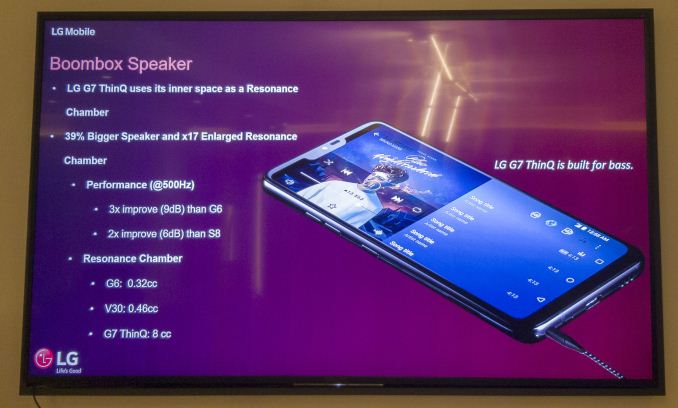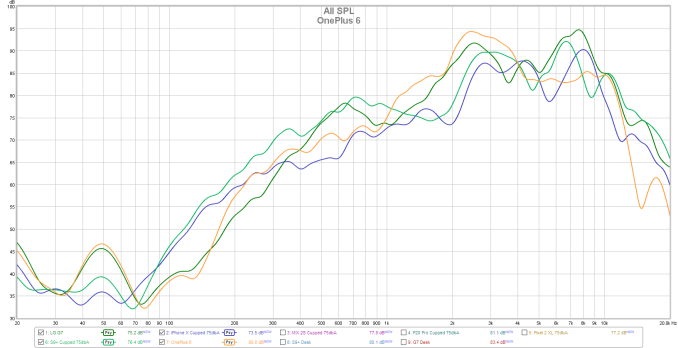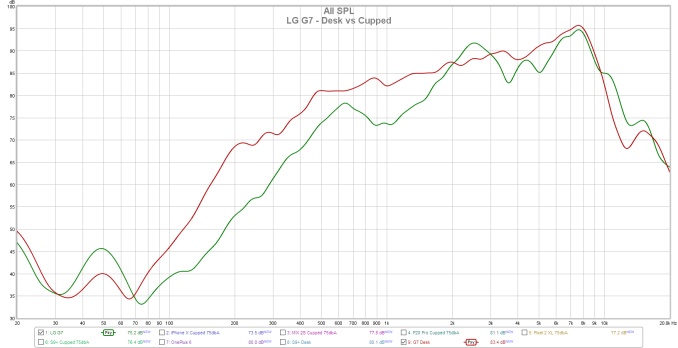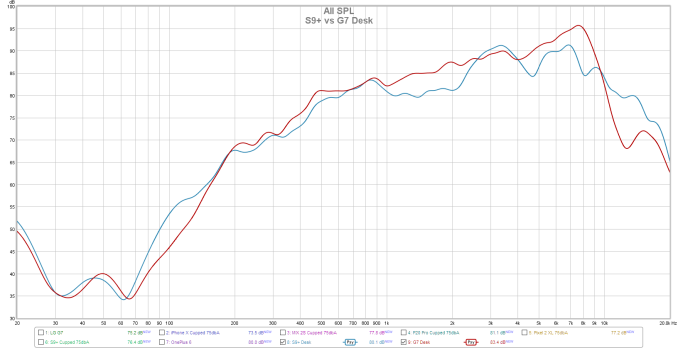The LG G7 Review: A Rushed Attempt?
by Andrei Frumusanu on August 9, 2018 11:00 AM EST- Posted in
- Smartphones
- LG
- Mobile
- LG G7 ThinQ
- LG G7
Video Recording
Video recording on the G7 is actually a very interesting topic because you have the two cameras to choose from. In terms of recording modes the phone is limited to 4K30 as its highest quality mode, while 60fps recording is enabled only for 1080p. There are also 18.9:9 aspect ratio resolutions at 2268x1080 and 1512x720 at 30fps which give you a wider field of view. EIS is only applied at 1080p30 and below.
In terms of encoding settings, the G7 only uses AVC/H.264 and doesn’t take advantage of the SoC’s more powerful HEVC encode mode. The encoding bitrates are standard for the respective resolutions and capture rates.
Main Camera:
Wide Angle:
| Recording Mode | AVC / H.264 |
| 3840p 30fps | High@L5.1 - 47.9 Mbps |
| 1080p 60fps | High@L4.2 - 24 Mbps |
| 1080p 30fps | High@L4 - 17 Mbps |
The 60fps capture modes suffer a lot from either a too low encoding bit-rate or the ISP isn’t doing as much processing, as it’s immediately visible that there’s far less dynamic range and detail compared to the 30fps modes. And it happens on both cameras.
1080p and 4K look good on both camera modules, although the lack of OIS is very visible in the wide-angle shooter. EIS functions extremely well and manages to retain a lot of detail – it’s to be noted that the occasional blurring jitter in the videos here is more of an effect of the YouTube transcoding, as the effect isn’t nearly as bad in the original video files.
What I really loved though about the G7 is the wide-angle recording in combination with EIS. I usually don’t enjoy EIS video capture because it really narrows your field-of-view too much in most cases, however on the G7 the wide-angle lens cancels out any disadvantages of the EIS, and you end up with a FOV that’s still wider than most other smartphones, with the benefit of great stabilisation.
The sound recording quality of the G7 was good, although I found that wind noise was a lot more pronounced than in other smartphones.
Overall the only larger criticism here is the loss of picture quality in the 60fps modes as well as overall the lack of being able to capture in HEVC as that would have noticeably increased picture quality without increasing file size.
Speaker Evaluation
LG made some big claims for the speaker of the G7 as it promised some really notable gains with its new design.
During our pre-brief we were presented with a few basic specs: the speaker is 39% bigger than on the G6, and also the resonance chamber is said to be the biggest of any smartphone. Instead of using the speaker housing as resonance chamber, the G7 uses the whole internal volume of the phone. This was also very much achieved thanks to the sealed nature of the phone through its IP68 rating. What this promises is vastly increased bass levels than any other phone.
First up though, let’s measure the speaker loudness. We’re using a flat response calibrated microphone and we’re measuring pink noise at a 40cm distance from the phone. The phone is held both one-handed in portrait mode, as well as two-handed with cupped palms in landscape; both of these should represent common use-cases for most people.

The results are extremely good for the G7, as it manages the loudest results among recent flagships. What is more remarkable still for the G7 is actually the directionality of the sound. Even though it only has one speaker and it’s bottom/side firing, this doesn’t seem to really hinder it much in terms of having excellent frontal directionality. I was really surprised at just how well this works and it easily outperforms even some true front-facing speakers of other phones. The sound directionality and evenness in portrait mode is particularly excellent.
Holding the phone in landscape is tougher though as it’s very much biased towards the side of the speaker and here the phone doesn’t fare as well as other stereo implementations.
Moving on to the frequency response of the speaker, we’re measuring a sweep from 20 to 20KHz, in the same conditions as our previous test, while holding the phone in landscape mode with two hands. All the phones are calibrated to the same loudness, aiming for 75dbA.
Although LG promised a lot of bass through the new speaker, it it actually ends up as one of the worst performers. The phone is significantly lacking in terms of depth, sounding very hollow. This is represented by the low SPL below 400Hz.
Investigating it more, one of the things LG did during the presentations of the phone is to showcase how the sound profile significantly changes when you lay it down on a surface. Indeed, while you hold the phone you can really feel the reverberations on the back glass of the phone. The problem here is that this is just wasted energy that doesn’t translate into any meaningful sound. Putting the phone on a standing surface allows the phone to transfer the vibrations and use the surface to amplify the sound.
I tested this out on my work desk, with once the phone held in my hand on the desk, and then again with the phone’s back flat against the desk.
Looking at the frequency response, we now see all that low frequency energy transfer to the desk and really amplify the low to mid frequencies of the phone, resulting in a much flatter frequency response.
To better represent the difference, here are two audio recordings of the two scenarios. Unfortunately I don’t have a proper omnidirectional recording microphone to capture this too well, so the recording was made with the measurement microphone – the issue with this one is that it lacks sufficient dynamic range and that’s why it sounds more muted. Here’s a recording of flat response speakers that should serve as an apples-to-apples baseline for comparison.
You can switch playback between the two recordings by pressing anywhere on the waveforms, and the recordings are synchronized in terms of their timestamps. This really represents the large audio profile difference between holding the G7 and putting it on a surface.
While this is all good in terms of looking at the frequency response, there’s a big catch when comparing the G7 to competitors. Putting the Galaxy S9+ onto the desk right next to the G7 and repeating the measurement, we actually see the Samsung phone perform even better in terms of bass as well as showcasing a significant advantage in the high frequencies.
When listening to the recording of the S9+ next to the G7, it puts the G7 into context, suddenly makes one question what the actual benefits of LG’s speaker design is. The coup de grâce for LG’s speaker is the fact that other phones don’t need to be put onto on a surface to be able so sound good; the S9+’s sound profile barely changes between holding it or putting it down. The G7 in the other hand just sounds bad when you’re holding it.
The most interesting fact is that when holding the phone, you can squeeze in the back side quite hard – what this does is reduce the internal reverberation and vibrations, and vastly increases the amplitude of lower frequencies actually coming out of the phone, noticeably improving the bass and depth of the audio.
Here’s the thing; while LG’s idea has some kind of merit and does work in some cases, a smartphone is still a handheld device, which by definition you hold it in your hand. Taking all of this into account, I don’t really see LG’s new speaker design paying off and I would even go as far to say that I somewhat prefer the G6’s sound, although that one isn’t great either.














69 Comments
View All Comments
melgross - Friday, August 10, 2018 - link
Interestingbthatvwhile they include theciphones in a few benchmarks, they aren’t mentioned in the article even once.lucam - Thursday, August 9, 2018 - link
iPad Pro review anytime soon? Or You guys have given up on testing tablets?collegsd - Friday, July 5, 2019 - link
https://bit.ly/2Xt0XYc
https://bit.ly/32jw9bk
ados_cz - Friday, August 10, 2018 - link
I got new G6 week ago and was really disappointed with the jpeg processing and softness of the ultrawide angle module. Then someone noted that Google Pixel camera app was ported to other snapdragon devices and gets much better results. You can still see that it is not perfect if you pixel-peep, but I am in peace with it now when using the ported app.https://photos.app.goo.gl/d4K6LH4oazGmboBK6
abufrejoval - Saturday, August 11, 2018 - link
Must be quite a sight, seeing you walk around Luxemburg taking pictures with dozens of phones...Andrei Frumusanu - Saturday, August 11, 2018 - link
It's more of an issue of having enough pockets...chadhumm - Saturday, August 11, 2018 - link
One comment. I loved LG's but I had to return the LGG7 the worst phone Ive ever had in regards to reception. Makes all the bells and whistles worthless. This in many areas city and rural. Traded for the S9 it is much better but not as good as the Motorola z force that I was replacing. Too bad because I had good luck with the g2 and g3nikon133 - Sunday, August 12, 2018 - link
I'm reasonably happy with G7. Got it for my work phone as it is much cheaper than S9+ here in NZ... $1000 vs $1500.Camera is my only real disappointment - yes it does watercolor greenery. That said, I am a bit of a camera freak, and there is no camera phone that really satisfies me - whenever I plan to shoot, I will have at least RX100 on me, if not dSLR. This makes me dislike G7 camera even more - but, at the same time, it makes me not care much as well, since I usually don't depend on phone cameras. Down-sampled to ~2MP (1080p full screen), photos are usable. This is really where my phone cameras' expectations end, regardless of model.
Oddly, screen color hasn't really impacted me, albeit I have moved to this phone from Nexus 5X and Lumia 950 XL... both should have decent screens, if memory serves. Might be because I use phone under different light and ever-changing conditions are preventing me from really having an issue with screen accuracy. Screen readability is quite good, even under sun, and resolution is a pleasure. I am wearing glasses for distance and they don't work well up close, so I usually look at the phone screen over the glasses, and, in result, bring phone very close to my face... where resolution shows more than from "normal" reading distance.
Battery holds well in my scenario. Even at the begging when phone use was higher than average - downloading and trying apps, setting accounts, running initial updates etc., I was not draining more than 60% between morning and evening. Everyday use it is 30 - 40%. Basically I can do full 2 days, and with wireless chargers at my office desk and bedside, absolutely no problems here... that said, I don't play games on phone.
Overall? Happy, so far. I'm aware of compromises, but price difference more than justifies them, imho. I am also not a big fan of Samsung's curved screen - it does nook nice but it also does expose screen more, judging from my colleagues' experiences with S7 Edge and S8.
jvl - Sunday, August 12, 2018 - link
But...does it Loop Good®?!? Or will we have to wait until we find out?Great_Scott - Thursday, August 16, 2018 - link
What this review did better than anything else was convince me to get a OnePlus6. It has the best camera at mid/high light levels and the (very well done) LCD screen of the G7 is inefficient at the lowest light levels (which is where I set my phone the vast majority of the time). The smaller-sized battery isn't great either.